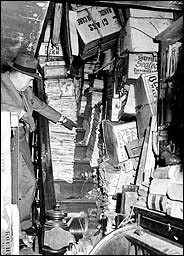The Collyer Brothers.

In 1942,
the Collyer brothers made the newspapers. They had defaulted on the mortgage
on their home and the bank came knocking on the door. The Bowery
Savings Bank began eviction procedures and a workcrew was sent over to
clean up the yard. Langley Collyer started screaming at the
workers and the police had to be called in. The cops ended
up smashing down the front door, only to encounter a wall of junk
piled up to keep people out. Silently, Langley wrote out a
check for $6,700 and paid off the mortgage in full. He ordered everyone
off of his premises and that was the last that the world had heard
of the Collyer brothers.
That was
until Friday, March 21, 1947 when a man named Charles Smith called police
headquarters at 10 A. M. claiming “There's a dead man in the premises at
2078 Fifth Avenue”. A patrolman was dispatched to the scene, but
he couldn't get into the building. There was no doorbell or
phone. The doors to the mansion were locked. The basement
windows were broken, but protected by iron grillwork. An emergency
squad of seven men had to be called in. The entranceway was blocked
by a wall of old newspapers, folding beds, one half of a sewing machine,
folding chairs, boxes, part of a wine press, and many other pieces
of junk. It was clear that the police were not getting through the front
door easily…
The policemen
decided upon another approach. They got a ladder and threw it against
the building. They attempted to go through the middle second floor
window instead. Well, they were out of luck. The brothers had
piled even more packages and bundles of old newspapers behind the
window opening. The police started to pull all of the junk out and
throw it down to the street below. Out came countless old newspapers,
empty cardboard boxes that were tied with rope, the frame ofa baby carriage,
a rake, two umbrellas tied together, and other stuff.
Once some of the
material was cleared away from the window, a patrolman was able to step
inside. Using a portable light, he was able to shove aside more bundles
of rubbish and found Homer Collyer sitting on the floor with his
head between his knees. The tiny old manes long and matted gray hair
reached down to his shoulders. He was only clad in an old,
ragged blue-and-white bathrobe. As the crowd outside the mansion
swelled to over 600 people, everyone started to wonder where Langley
was. Could he be wandering around the city on errands?
Could he still be in the house in hiding? Was he the one that
called in the tip to the police? No one was really sure.
The following
Monday the police began their search of the house for the missing brother.
Out came more junk – gas chandeliers, the folding top of a horse drawn
carriage, a rusted bicycle, three dressmaking dummies, a saw horse, a doll
carriage, a rusted bed spring, a kerosene stove, a checkerboard, a child's
chair, countless old newspapers, pinup girl photos, and so on. The next
day the police returned and pulled out an intricate potato peeler, a beaded
lampshade, the chassis of an old car, children's toys, and over six tons
of newspapers, magazines, and wood. On the third day even more stuff was
taken out of the house. Anything deemed worthless was just tossed
out the window to the ground below. Items of value were placed
in storage. On the fourth day the police continued their removal of
junk from the home. In the search for Langley, they found an assortment
of guns and ammunition. Near thelocation that Homer died, an assortment
of bankbooks was discovered for a total worth of just $3,007.00.
Monday
came around and, again, the police removed more junk from the home.
This included over 3,000 books, plenty of outdated phone books, a
horse's jawbone, a Steinway piano, a primitive X-ray machine, and
more bundles of newspapers. By the end of the day a total of over
nineteen tons of junk had been removed from the first floor of the house
alone! And the search continued. Every day more stuff was taken
from the home. Old medical equipment, human medical specimens,
a wide variety of musical instruments, and (of course) more bundles of
old newspapers.
Day after
day, more and more junk was removed from the home. By Monday, April
7th, 136 tons of essentially worthless garbage had been taken from the
house. On Tuesday April 8, 1947 the body of Langley Collyer was finally
located. Believe it or not, he was less than ten feet from
where his brother Homer had died. His body was partly decomposed
and was being gnawed on by a big ugly rat. A suitcase, three metal bread
boxes, and – you guessed it – bundles of newspapers were covering his body.
In the end,
investigators concluded that Langley was asphyxiated after one of his booby
traps collapsed down on him. They believe that he was crawling through
the tunnel-like maze in an effort to bring food to his paralyzed
and blind brother Homer. With no one to feed him, Homer essentially
starved to death.
The brothers
estate was valued at $91,000 in real estate and $20,000 in personal property.
What was salvageable from the 136 tons of junk that had been collected
sold for less than $2000 at auction. Their once beautiful mansion
was condemned, torn down, and is now a parking lot.
Now we have
just one unanswered question. What was the deal with all of
those newspapers? Langley provided an answer in a 1942 New York Herald
Tribune interview. “I am saving newspapers for Homer, so that
when he regains his sight he can catch up on the news.”
